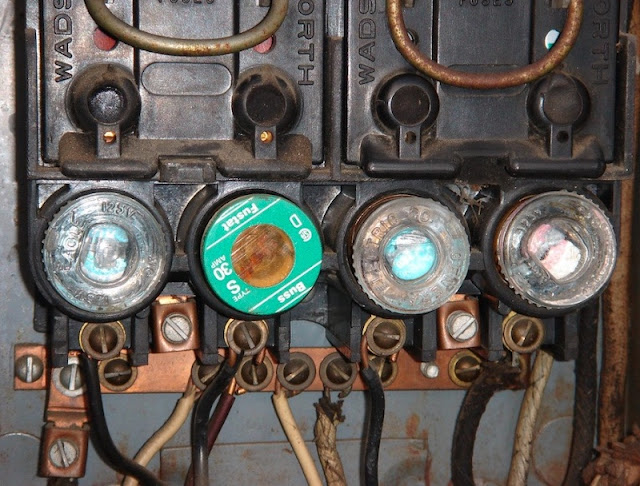Here’s a prime example. The first photo is a fuse box found in a Southeast Michigan property. Fuse boxes are most commonly found in homes build before the 1970s. More recently, and often, you will see circuit breakers in your electrical panel. This is shown in the second photo, also found in Southeast Michigan.

You may have heard the phrase, ‘I blew a fuse’. Whether it’s your car, your house, or yourself (for some of us), a fuse blows when there is too much (current, measured in Amps) demand on a circuit and it (melts) blows. This disconnects the circuit. A noise is typically associated as that’s what you can hear when a fuse blows. Once a fuse blows, it has to be replaced. Luckily fuses are cheap and they protect your expensive alliances from blowing instead
As society has gravitated towards using more and more electricity to power laundry/kitchen appliances, TVs, gaming systems, toys, etc.. fuse boxes haven’t been able to keep up with the demand (Amps required to run those devices). In addition to blowing a fuse, the danger in running overloading the circuit can lead to a fire. This is due to the fact that the fuse actually heats up from the overloading and then the fuse melts. That heat build up is a fire hazard.
In turn, on a circuit breaker, when there is overloading on a circuit then the breaker will ‘trip’. You may have heard that term before. When the breaker trips, it moves to the “off” position and disconnects the circuit. This protects the appliance(s) and you don’t have to replace the breaker, like replacing a blown fuse. To reconnect, you just have to flip the breaker back to the “on” position.
Circuit breakers are also susceptible to fires as well. They do heat up when there is overloading on the circuit. If there is a faulty breaker that doesn’t trip, then there is nothing to stop the overloading current from flowing. Either way, it’s important to keep your home electrical panel well maintained and inspected. If you have access to a thermal imagine camera, similar to one I showcased in a previous post, use it and that will clearly identify a circuit that is running HOT!

You may have heard the phrase, ‘I blew a fuse’. Whether it’s your car, your house, or yourself (for some of us), a fuse blows when there is too much (current, measured in Amps) demand on a circuit and it (melts) blows. This disconnects the circuit. A noise is typically associated as that’s what you can hear when a fuse blows. Once a fuse blows, it has to be replaced. Luckily fuses are cheap and they protect your expensive alliances from blowing instead
As society has gravitated towards using more and more electricity to power laundry/kitchen appliances, TVs, gaming systems, toys, etc.. fuse boxes haven’t been able to keep up with the demand (Amps required to run those devices). In addition to blowing a fuse, the danger in running overloading the circuit can lead to a fire. This is due to the fact that the fuse actually heats up from the overloading and then the fuse melts. That heat build up is a fire hazard.
In turn, on a circuit breaker, when there is overloading on a circuit then the breaker will ‘trip’. You may have heard that term before. When the breaker trips, it moves to the “off” position and disconnects the circuit. This protects the appliance(s) and you don’t have to replace the breaker, like replacing a blown fuse. To reconnect, you just have to flip the breaker back to the “on” position.
Circuit breakers are also susceptible to fires as well. They do heat up when there is overloading on the circuit. If there is a faulty breaker that doesn’t trip, then there is nothing to stop the overloading current from flowing. Either way, it’s important to keep your home electrical panel well maintained and inspected. If you have access to a thermal imagine camera, similar to one I showcased in a previous post, use it and that will clearly identify a circuit that is running HOT!
Comments
Post a Comment